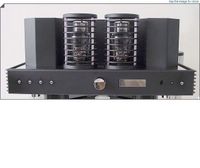Back to TAS Roundtable. No big surprises, Mr. Tiefenbrun maintained the Linn's traditional stand that the source is the most important,
Messr. Wilson said "...three most important factors. First is the microphone used in the recordings. Another is room acoustics, and then third is loudspeakers." The microphone? Remember that Wilson started his audio career in recording business with his wife, who continues to run that business.
The TAS representatives were less categorical. Wayne Garcia: "...for me, balance is the key. But if pressed, I would ultimately go to the source." Jonathan Valin noted that he has never heard a truly satisfying system in which front end wasn't first-rate. He went on emphasizing importance of pre-amp, and that speakers' characteristics should match listener's primary musical taste. "I would not spend the bulk of my money on a loudspeaker whose many virtues I wouldn't need or use." Furthermore, he counseled consumers to build a system, which as a whole, would faithfully reproduce those qualities of music that a listener values and makes "your music consistently enjoyable to listen to..."
Harry Pearson: "I think I would come down on the side of the speakers, simply because if you buy a good speaker system, you will not need to replace it as you're working on the chain."
All participants assumed that a system is not static, but one that changes over time. Wayne Garcia raised a good point by saying that not all listeners want to upgrade: "Not every customer wants to make it a hobby." A lot of people want just to buy a system with a given budget, take it home and enjoy music years to come.
Viewpoint: As I said in the beginning, read the original article, it's worthwhile. My views about the system building reflect to some extent various opinions put forward by the Roundtable participants. Naturally I make assumption here that your are a melomane/audiophile, i.e. that music matters you so much that you invest time and money in your hi-fi system to make it more enjoyable.
First, I call for balance, but not in budget allocation but in terms of performance. Although price/performance is quite linear with audio components (with diminishing return), careful testing and listening can results in some components costing (substantially) less than initially reckoned, because they provide superior price/performance
in the context of a particular system. This most often occurs because of synergies between different components make 1+1 equal 3 in sonic terms.
Second, for any serious hifi system I would always allocate some 10-15% to "secondary" components, i.e. to cables, racks and tweaks (like isolation devices). The secondary components behave like subtle tune controls. They can enhance the virtues a listener feels important in his/her sound, but you can never make any components
fundamentally better. If "it" doesn't exist in primary components - like resolution - then secondary components are not going to make "it" audible.
Third, buying a system as "balanced" holds a trap. The end-result might not develop enough enjoyment and involvement, leaving an owner unenthusiastic to invest further in his system.
Fourth, I advocate having an anchor point is your system, and that cornerstone should be a pre-amplifier. I'm a relic here as I'm only referring to 2-channel pre-amp. If you are intrigued by new "audiophile" formats (I'm not, for various reasons) like SACD and DVD-A in multi-channel format, look elsewhere. However, my experience is that most audiophiles enjoy increasingly more new formats in 2-channel set-up, so you might continue reading.
Following logically the cornerstone thinking you might conclude that it's the best to make the speakers an anchor. I beg to differ, and let me give you an example. I used to drive my power amp directly from the source, using Mark Levison 390S CD-player's analogue volume control. And that volume control is no slouch (attenuator implemented with Vishay resistors). A typical "lets keep signal path as short as possible" mantra. But still I preferred the sound with an inexpensive tube pre-amp with NOS tubes injected into the system, in this case €1200 (with NOS tubes) Eastern Electric MiniMax. The end-result was more involving, enhancing the virtues I appreciate in music listening like soundstaging and imaging - and this in a system costing close to €45,000. This was the definitive moment for me as I realize that the speakers and the source are extremes, and the pre-amp acts like a valve between them.
Consequently I decided to take pre-amp on the same level as the rest of the system, and ARC LS25 mk2 pre-amp provided me with even more satisfying sound, and finally replacing the stock tubes by better NOS tubes (6H30 DR grade) took performance yet to the different level.
So am I bragging around about my gear or is there a message here? The point is that in order to hear
what your source can decode from CDs, LPs or new formats and
how your speakers can finally re-produce the signal you need the best "valve" in between, i.e. the pre-amp. So my advice is to spend disproportionally to (tube) pre-amplifier, and then use that as reference to build the system over time.
Why tube pre-amp? Because you get harmonic completeness, timber richness, coherence and and convincing three-dimensional soundstaging. Don't take my word for it, experience with tubes.
Fifth, when "the speakers come first" school emphasize the quality of speakers, way too often they forget to say that equally important is speakers' interaction with the room. The speakers have to match the room size and characteristics. For example, in the Nordic countries rooms tend to be constructed differently than, lets say, in the US or France. A typical Nordic room is relatively small, with concrete floor and walls and double-glazing windows. This kind of construction presents utterly different interaction with any speaker than a large room in a wood construction house with large, single-glazing windows. Also for this reason consumers should read foreign audio reviews carefully - and I'm not a xenophobic in saying that ;)
Some closing notes. One of the more frustrating uncertainties facing high performance audio is determining the ultimate capabilities of a component. Being able to identify a component as excellent is easy enough. Knowing exactly just how excellent is rather more ambiguous. Since any component will only be audible when placed in a system, judging its ultimate limits requires that one knows the ultimate prowess of each component in the system, each of which in turn faces the same dilemma. Upgrading an individual component becomes a shot in the dark: will the upgrade bring a genuine improvement
in system sound and will the rest of the system be capable of resolving the difference?
The larger, far more important questions should always be the central concern: is the component in question producing more musical information? Is it more faithful to the music? Is it, thus, higher fidelity? For quite many audiophiles engaged with system building difference
per se is reported immediately to be good, and yet after the long term listening new component's or tweak's shortcomings become evident and audible.
We audiophiles devote a lot of time building our audio system towards higher fidelity, and we like to read audio magazines and peer group reviews (at least for positive reinforcing). As for reviews, the old rule prevails. The purpose of audio reviews is not to make choice for a reader. It is rather to help potential buyer to know what products merit a visit to a dealer showroom - or more preferably, leads into home trial within listener's own system.
And yet if we've managed to build a truly high-end hifi system that is capable to reproduce to the highest fidelity the original recording, we have only completed a half of audio circle. What we are often sadly experiencing is non-audiophile recordings. With recordings "audiophile" simply means that the same care goes into the front end that goes into the back end. The studios, which have invested in state-of-the-art recording chain and the highest quality available signal path, basically completes the audiophile circle. Once a melomane plays the recording at home, that's the other half, a studio keen to make the highest quality possible recording is the first half.





